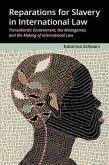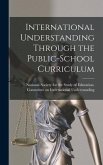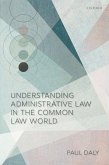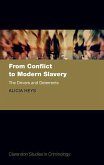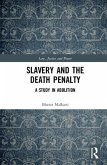- Gebundenes Buch
- Merkliste
- Auf die Merkliste
- Bewerten Bewerten
- Teilen
- Produkt teilen
- Produkterinnerung
- Produkterinnerung
This book examines how slavery is understood in law. It shows how the legal definition of slavery has evolved and continues to be contentious. It traces the understanding of slavery from Roman law through the Middle Ages, the 18th and 19th centuries, up to the modern day manifestations, including forced labour and trafficking in persons.
Andere Kunden interessierten sich auch für
![Reparations for Slavery in International Law Reparations for Slavery in International Law]() Katarina SchwarzReparations for Slavery in International Law138,99 €
Katarina SchwarzReparations for Slavery in International Law138,99 €![International Understanding Through the Public-school Curriculum International Understanding Through the Public-school Curriculum]() International Understanding Through the Public-school Curriculum42,99 €
International Understanding Through the Public-school Curriculum42,99 €![Understanding Administrative Law in the Common Law World Understanding Administrative Law in the Common Law World]() Paul DalyUnderstanding Administrative Law in the Common Law World133,99 €
Paul DalyUnderstanding Administrative Law in the Common Law World133,99 €![The Slavery of the British West India Colonies Delineated, as it Exists Both in law and Practice, and Compared With the Slavery of Other Countries, An The Slavery of the British West India Colonies Delineated, as it Exists Both in law and Practice, and Compared With the Slavery of Other Countries, An]() James StephenThe Slavery of the British West India Colonies Delineated, as it Exists Both in law and Practice, and Compared With the Slavery of Other Countries, An44,99 €
James StephenThe Slavery of the British West India Colonies Delineated, as it Exists Both in law and Practice, and Compared With the Slavery of Other Countries, An44,99 €![From Conflict to Modern Slavery From Conflict to Modern Slavery]() Alicia HeysFrom Conflict to Modern Slavery127,99 €
Alicia HeysFrom Conflict to Modern Slavery127,99 €![Slavery and the Death Penalty Slavery and the Death Penalty]() Bharat MalkaniSlavery and the Death Penalty190,99 €
Bharat MalkaniSlavery and the Death Penalty190,99 €![Regional Trade Agreements and the WTO Legal System Regional Trade Agreements and the WTO Legal System]() Lorand Bartels / Federico Ortino (eds.)Regional Trade Agreements and the WTO Legal System388,99 €
Lorand Bartels / Federico Ortino (eds.)Regional Trade Agreements and the WTO Legal System388,99 €-
-
-
This book examines how slavery is understood in law. It shows how the legal definition of slavery has evolved and continues to be contentious. It traces the understanding of slavery from Roman law through the Middle Ages, the 18th and 19th centuries, up to the modern day manifestations, including forced labour and trafficking in persons.
Hinweis: Dieser Artikel kann nur an eine deutsche Lieferadresse ausgeliefert werden.
Hinweis: Dieser Artikel kann nur an eine deutsche Lieferadresse ausgeliefert werden.
Produktdetails
- Produktdetails
- Verlag: Oxford University Press (UK)
- Seitenzahl: 416
- Erscheinungstermin: 25. November 2012
- Englisch
- Abmessung: 236mm x 157mm x 30mm
- Gewicht: 771g
- ISBN-13: 9780199660469
- ISBN-10: 0199660468
- Artikelnr.: 36392225
- Herstellerkennzeichnung
- Libri GmbH
- Europaallee 1
- 36244 Bad Hersfeld
- gpsr@libri.de
- Verlag: Oxford University Press (UK)
- Seitenzahl: 416
- Erscheinungstermin: 25. November 2012
- Englisch
- Abmessung: 236mm x 157mm x 30mm
- Gewicht: 771g
- ISBN-13: 9780199660469
- ISBN-10: 0199660468
- Artikelnr.: 36392225
- Herstellerkennzeichnung
- Libri GmbH
- Europaallee 1
- 36244 Bad Hersfeld
- gpsr@libri.de
Jean Allain is Professor of Public International Law at Queen's University, Belfast. He is Extraordinary Professor, Centre for Human Rights, Faculty of Law, University of Pretoria, South Africa. He is founding Editor of the Irish Yearbook of International Law and the author of The Slavery Conventions (2008) and Slavery in International Law (2012).
* Bellagio-Harvard Guidelines on the Legal Parameters of Slavery
* Introduction
* Section 1: Historical Readings of the Law of Slavery
* 1: Antony Honoré: The Nature of Slavery
* 2: Richard Helmholz: The Law of Slavery in European ius commune
* 3: Bernard Freamon: Definition and Conceptions of Slave Ownership in
Islamic Law
* 4: John Cairns: The Definition of Slavery in Eighteenth-Century
Thinking: Not the True Roman Slavery
* 5: Seymour Drescher: From Consensus to Consensus: Slavery in
International Law
* Section 2: The American Experience: Blurred Boundaries of Slavery
* 6: Paul Finkelman: Slavery in the United States: Persons or
Property?,
* 7: Allison Mileo Gorsuch: To Indent Oneself: Ownership, Contracts,
and Consent in Antebellum Illinois
* 8: Rebecca Scott: Under Color of Law: Siliadin v. France and the
Dynamics of Enslavement in Historical Perspective
* 9: Stanley Engerman: The Rise, Persistence, and Slow Decline of Legal
Slavery
* 10: William M. Carter, Jr.: The Abolition of Slavery in the United
States: Historical Context and its Contemporary Application
* Section 3: The 1926 Definition in Context
* 11: Jean Allain: The Definition of Slavery into the Twenty-First
Century
* 12: Robin Hickey: Seeking to Understand the Definition of Slavery
* 13: J. E. Penner: The Concept of Property and the Concept of Slavery
* 14: Joel Quirk: Defining Slavery in all its Forms: Historical Inquiry
as Contemporary Instruction
* Section 4: Contemporary Slavery
* 15: Kevin Bales: Slavery in its Contemporary Manifestations
* 16: Holly Cullen: Contemporary International Legal Norms on Slavery:
Problems of Judicial Interpretation and Application
* 17: Orlando Patterson: Trafficking, Gender, and Slavery: Past and
Present
* 18: Professor Kevin Bales' Response to Professor Orlando Patterson
* 19: Professor Patterson Rejoiner: A Response to Professor Kevin Bales
* Appendices
* 1926 Slavery Convention
* 1956 Supplementary Convention on the Abolition of Slavery, the Slave
Trade, and Institutions and Practices Similar to Slavery
* Introduction
* Section 1: Historical Readings of the Law of Slavery
* 1: Antony Honoré: The Nature of Slavery
* 2: Richard Helmholz: The Law of Slavery in European ius commune
* 3: Bernard Freamon: Definition and Conceptions of Slave Ownership in
Islamic Law
* 4: John Cairns: The Definition of Slavery in Eighteenth-Century
Thinking: Not the True Roman Slavery
* 5: Seymour Drescher: From Consensus to Consensus: Slavery in
International Law
* Section 2: The American Experience: Blurred Boundaries of Slavery
* 6: Paul Finkelman: Slavery in the United States: Persons or
Property?,
* 7: Allison Mileo Gorsuch: To Indent Oneself: Ownership, Contracts,
and Consent in Antebellum Illinois
* 8: Rebecca Scott: Under Color of Law: Siliadin v. France and the
Dynamics of Enslavement in Historical Perspective
* 9: Stanley Engerman: The Rise, Persistence, and Slow Decline of Legal
Slavery
* 10: William M. Carter, Jr.: The Abolition of Slavery in the United
States: Historical Context and its Contemporary Application
* Section 3: The 1926 Definition in Context
* 11: Jean Allain: The Definition of Slavery into the Twenty-First
Century
* 12: Robin Hickey: Seeking to Understand the Definition of Slavery
* 13: J. E. Penner: The Concept of Property and the Concept of Slavery
* 14: Joel Quirk: Defining Slavery in all its Forms: Historical Inquiry
as Contemporary Instruction
* Section 4: Contemporary Slavery
* 15: Kevin Bales: Slavery in its Contemporary Manifestations
* 16: Holly Cullen: Contemporary International Legal Norms on Slavery:
Problems of Judicial Interpretation and Application
* 17: Orlando Patterson: Trafficking, Gender, and Slavery: Past and
Present
* 18: Professor Kevin Bales' Response to Professor Orlando Patterson
* 19: Professor Patterson Rejoiner: A Response to Professor Kevin Bales
* Appendices
* 1926 Slavery Convention
* 1956 Supplementary Convention on the Abolition of Slavery, the Slave
Trade, and Institutions and Practices Similar to Slavery
* Bellagio-Harvard Guidelines on the Legal Parameters of Slavery
* Introduction
* Section 1: Historical Readings of the Law of Slavery
* 1: Antony Honoré: The Nature of Slavery
* 2: Richard Helmholz: The Law of Slavery in European ius commune
* 3: Bernard Freamon: Definition and Conceptions of Slave Ownership in
Islamic Law
* 4: John Cairns: The Definition of Slavery in Eighteenth-Century
Thinking: Not the True Roman Slavery
* 5: Seymour Drescher: From Consensus to Consensus: Slavery in
International Law
* Section 2: The American Experience: Blurred Boundaries of Slavery
* 6: Paul Finkelman: Slavery in the United States: Persons or
Property?,
* 7: Allison Mileo Gorsuch: To Indent Oneself: Ownership, Contracts,
and Consent in Antebellum Illinois
* 8: Rebecca Scott: Under Color of Law: Siliadin v. France and the
Dynamics of Enslavement in Historical Perspective
* 9: Stanley Engerman: The Rise, Persistence, and Slow Decline of Legal
Slavery
* 10: William M. Carter, Jr.: The Abolition of Slavery in the United
States: Historical Context and its Contemporary Application
* Section 3: The 1926 Definition in Context
* 11: Jean Allain: The Definition of Slavery into the Twenty-First
Century
* 12: Robin Hickey: Seeking to Understand the Definition of Slavery
* 13: J. E. Penner: The Concept of Property and the Concept of Slavery
* 14: Joel Quirk: Defining Slavery in all its Forms: Historical Inquiry
as Contemporary Instruction
* Section 4: Contemporary Slavery
* 15: Kevin Bales: Slavery in its Contemporary Manifestations
* 16: Holly Cullen: Contemporary International Legal Norms on Slavery:
Problems of Judicial Interpretation and Application
* 17: Orlando Patterson: Trafficking, Gender, and Slavery: Past and
Present
* 18: Professor Kevin Bales' Response to Professor Orlando Patterson
* 19: Professor Patterson Rejoiner: A Response to Professor Kevin Bales
* Appendices
* 1926 Slavery Convention
* 1956 Supplementary Convention on the Abolition of Slavery, the Slave
Trade, and Institutions and Practices Similar to Slavery
* Introduction
* Section 1: Historical Readings of the Law of Slavery
* 1: Antony Honoré: The Nature of Slavery
* 2: Richard Helmholz: The Law of Slavery in European ius commune
* 3: Bernard Freamon: Definition and Conceptions of Slave Ownership in
Islamic Law
* 4: John Cairns: The Definition of Slavery in Eighteenth-Century
Thinking: Not the True Roman Slavery
* 5: Seymour Drescher: From Consensus to Consensus: Slavery in
International Law
* Section 2: The American Experience: Blurred Boundaries of Slavery
* 6: Paul Finkelman: Slavery in the United States: Persons or
Property?,
* 7: Allison Mileo Gorsuch: To Indent Oneself: Ownership, Contracts,
and Consent in Antebellum Illinois
* 8: Rebecca Scott: Under Color of Law: Siliadin v. France and the
Dynamics of Enslavement in Historical Perspective
* 9: Stanley Engerman: The Rise, Persistence, and Slow Decline of Legal
Slavery
* 10: William M. Carter, Jr.: The Abolition of Slavery in the United
States: Historical Context and its Contemporary Application
* Section 3: The 1926 Definition in Context
* 11: Jean Allain: The Definition of Slavery into the Twenty-First
Century
* 12: Robin Hickey: Seeking to Understand the Definition of Slavery
* 13: J. E. Penner: The Concept of Property and the Concept of Slavery
* 14: Joel Quirk: Defining Slavery in all its Forms: Historical Inquiry
as Contemporary Instruction
* Section 4: Contemporary Slavery
* 15: Kevin Bales: Slavery in its Contemporary Manifestations
* 16: Holly Cullen: Contemporary International Legal Norms on Slavery:
Problems of Judicial Interpretation and Application
* 17: Orlando Patterson: Trafficking, Gender, and Slavery: Past and
Present
* 18: Professor Kevin Bales' Response to Professor Orlando Patterson
* 19: Professor Patterson Rejoiner: A Response to Professor Kevin Bales
* Appendices
* 1926 Slavery Convention
* 1956 Supplementary Convention on the Abolition of Slavery, the Slave
Trade, and Institutions and Practices Similar to Slavery


